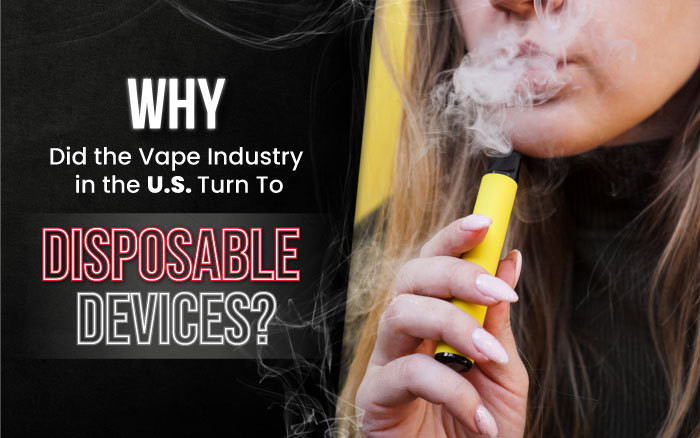Why Did the Vape Industry in the U.S. Turn To Disposable Devices?
Estimated 0 min read
Why Did the Vape Industry in the U.S. Turn To Disposable Devices?
There are two types of reasons why the disposable vape market has seen such tremendous growth in the past few years: One motive is user-based and the other is law-based. Today we will take a look at both.
In three years, disposables went from being a product that barely made a mark to becoming a nearly $2 billion industry. Why is that?
What Made Vape Disposable Brands So Popular?
For starters, disposables are attractive products for retail stores to carry because they have a high repurchase rate. Disposable vapes are designed so the user has to repurchase a whole product (including vape juice and battery) every time they empty a tank. This makes it necessary for the user to repurchase the product more often than they would with bottled e-juices, making it a very attractive consumable for retailers.
This is what likely prompted vape shops and other brick-and-mortar stores to start carrying disposable vapes in the first place. By ‘other stores’ we’re mainly referring to convenience stores and gas stations, where disposable vapes have become incredibly popular. Especially for small-time manufacturers that have found a great distribution alternative that is not as strictly regulated as lawfully established vape shops.
That said:
Most of the growth of the disposable vape market happened between 2019 and 2022. This coincides with the pandemic and also with the removal of Juul Labs’ flavored pod products from the legal market. This means that it is highly likely that the disposable vape market grew as rapidly as it did in part due to the flavored vape pod ban itself.
Since then, the FDA has cracked down on vape shops and brands that have submitted documents with the intention of following FDA regulations. It is entirely possible that a large part of the success of disposables in convenience stores and gas stations is due to the FDA’s efforts to go after brands being sold in regulated establishments that cater to vapers almost exclusively, primarily because it's easier for the agency to regulate this type of establishment.
Disposables are easy to find for the user but hard for the FDA to track in this market. Which is why the niche continues to grow even if many of the top-selling brands in convenience stores and gas stations have yet to be authorized by the FDA.
In other words:
The $2 billion industry we’re talking about is likely to be made up of mostly products that do not follow FDA requirements. But the FDA continues to crack down on those that do.
From a user perspective, disposables are popular among users because they are convenient, small, easy to use, rechargeable, and inexpensive. Which would attribute the qualities that make them attractive to consumers and, therefore, to retailers as well.
Final Thoughts
There is a need for the FDA to regulate the vape industry in the U.S., especially when it comes to popular disposable vape brands. But perhaps the way of doing so is only taking into account a piece of the puzzle, hence making it easier for smaller companies to sell disposable vapes that do not follow FDA rules and, in turn, more difficult for companies that abide by the rules to cater to their customers.







